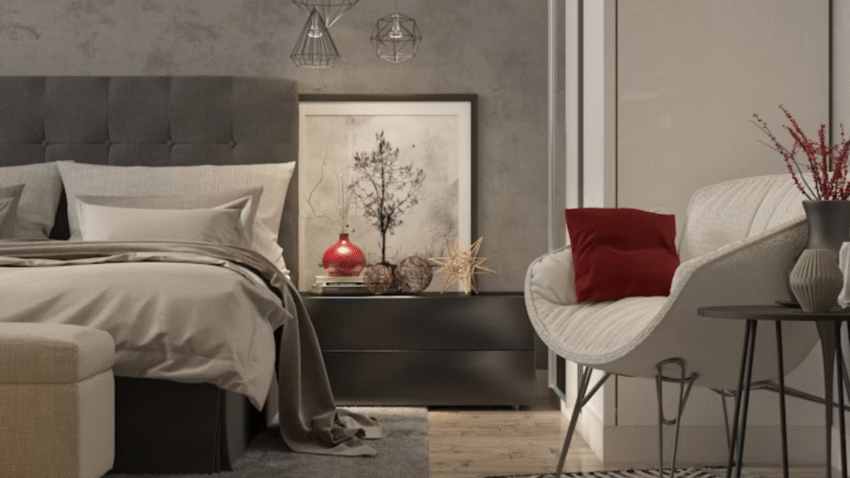Introduction
Are you tossing and turning because every creak, street sound, or snoring partner keeps you awake? You’re not alone. Learning how to reduce noise for better sleep in your bedroom can transform your nights from restless to restful. Whether you live near a busy street, have loud neighbors, or share your room with someone who snores, this guide will help you create a peaceful sleep environment so you can drift off—and stay asleep—more easily.
Why Noise Reduction Matters for Sleep
Your bedroom should be your sanctuary, but noise pollution is one of the most common sleep disruptors. Even low-level background noise can prevent you from reaching deep, restorative sleep stages, leaving you tired and groggy the next day. Reducing unwanted sounds improves your sleep quality, helps you fall asleep faster, and supports your mental and physical health. A quiet bedroom is an investment in better energy, mood, and focus every day.
Step-by-Step Guide to Reducing Noise in Your Bedroom
1. Identify Your Main Noise Sources
Before you tackle the noise, figure out what’s keeping you awake.
- Is it outside traffic, barking dogs, or noisy neighbors?
- Or is it indoor sounds like a partner snoring, squeaky floors, or rattling pipes?
- Pinpointing the source helps you choose the best solutions.
2. Soundproof Your Windows
Windows are often the biggest culprit for outdoor noise.
- Use thick, heavy blackout curtains—they help block light and muffle sounds.
- Install double-glazed or storm windows if you own your home.
- Add weatherstripping or window inserts to seal gaps and reduce drafts that carry noise.
3. Add Rugs or Carpeting
Hard floors like wood or tile can bounce sound around your bedroom.
- Lay down thick area rugs or install carpeting to absorb noise.
- Place a rug pad underneath for extra sound dampening.
- If you share walls with neighbors, adding rugs can help reduce noise from above or below too.
4. Use a White Noise Machine or Fan
If you can’t block all the noise, mask it.
- White noise machines create a constant, soothing background sound that covers up sudden noises.
- A simple fan can have the same effect and keep your room cool.
- There are also apps with rain sounds, ocean waves, or ambient noise for your phone.
5. Rearrange Your Bedroom Layout
Where your bed sits in the room can make a big difference.
- Move your bed away from shared walls or windows facing the street.
- Place your headboard against the quietest wall in the room.
- Use large furniture like bookshelves against noisy walls to add an extra sound barrier.
6. Seal Gaps and Cracks
Even tiny gaps can let in a surprising amount of noise.
- Check doors and windows for cracks and seal them with weatherstripping or caulk.
- Use door sweeps to block sound from hallways.
- Hang thick curtains over doors or use draft stoppers for added protection.
7. Hang Soundproofing Panels or Tapestries
Decor can double as noise reduction.
- Install acoustic panels or foam tiles on walls that face the noise source.
- Hang heavy fabric tapestries or wall hangings to dampen sound.
- Upholstered headboards can also help absorb noise near your bed.
8. Consider Earplugs or Noise-Canceling Headphones
For especially stubborn noise problems, personal solutions can help.
- Use soft, comfortable earplugs designed for sleep.
- Try noise-canceling sleep headphones with calming music or white noise.
- Always test earplugs first to ensure they’re comfortable and safe for overnight use.
9. Address Indoor Noise Sources
Sometimes the noise comes from inside your own home.
- Tighten squeaky floorboards or bed frames.
- Lubricate door hinges and close doors softly at night.
- If you share your room with a snorer, consider positional pillows or consult a doctor for sleep apnea solutions.
Common Mistakes to Avoid
Mistake 1: Ignoring Small Gaps and Cracks
Solution: Even small openings let sound leak in—seal gaps around windows and doors thoroughly.
Mistake 2: Using Thin Curtains Only for Light Blocking
Solution: Invest in heavyweight blackout curtains that dampen sound as well as light.
Mistake 3: Placing the Bed on the Noisiest Wall
Solution: Always position your bed on the wall furthest from noise sources like windows, streets, or shared walls.
Mistake 4: Forgetting to Mask Residual Noise
Solution: If you can’t eliminate noise completely, use a white noise machine, fan, or sleep app to mask it.
Mistake 5: Overlooking Flooring
Solution: Bare floors echo sound. Add rugs or carpeting to absorb noise and make the room cozier.
Extra Tips & Bedroom Hacks
- Double Up on Curtains: Layer blackout curtains over sheer panels for style and extra sound protection.
- Soundproof Doors: If your door is hollow, consider upgrading to a solid-core door for better noise control.
- Related Guide: Want to boost your sleep even more? Check out our step-by-step article on how to get rid of bedroom allergens for a healthier, quieter sleep space.
Conclusion
Knowing how to reduce noise for better sleep in your bedroom can turn your nights from restless to restful. By soundproofing windows and doors, adding rugs and curtains, using white noise, and rearranging your space, you can create a peaceful environment that helps you sleep deeply and wake up refreshed.
Remember: a few smart changes can make a huge difference. Bookmark this guide to keep your bedroom calm, quiet, and perfectly primed for great sleep every night!
